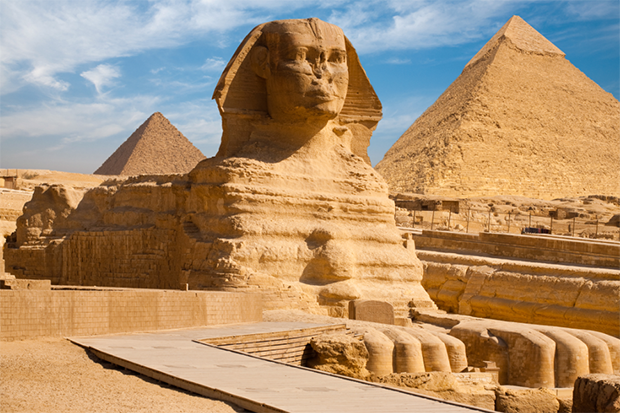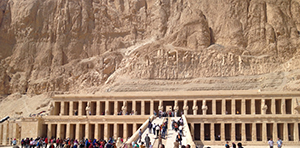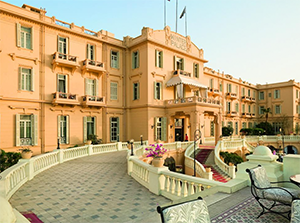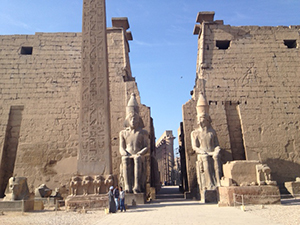A Weekend in Egypt

By Jon Haggins
Photos by Laurel Van Horn
While most people plan a trip abroad, especially to a place as far away as the Mid-East, for at least a week and perhaps more, sometimes the opportunity to spend just a few days is too intriguing to miss.
Imagine a weekend in the wonders of Egypt. This was my first return in seventeen years. Arriving in Cairo is always an experience with bumper-to-bumper traffic like no other place in the world. I stayed in the Marriott Cairo Hotel on the Nile with a river view of the party boats.
We visited the pyramids and what I discovered were new improvements such as paved roads in the desert for better access. The pyramids remain the same... fortunately.

None are more celebrated than the Great Pyramids of Giza, located on a plateau on the west bank of the Nile River on the outskirts of modern-day Cairo. The oldest and largest of the three pyramids in Giza is the Great Pyramid, the only surviving structure out of the famed seven wonders of the ancient world. It was built for Khufu (Cheops, in Greek), Sneferu’s successor and the second of the eight kings of the fourth dynasty.
Though Khufu reigned for 23 years (2589-2566 B.C.), relatively little is known of his reign beyond the grandeur of his pyramid. The sides of the pyramid’s base average 755.75 feet, and its original height was 481.4 feet, making it the largest pyramid in the world. Three small pyramids built for Khufu’s queens are lined up next to the Great Pyramid. The middle pyramid at Giza was built for Khufu’s son Khafre (2558-2532 B.C). The southernmost pyramid at Giza was built for Khafre’s son, Menkaure (2532-2503 B.C.). It is the shortest of the three pyramids (218 feet).
Camel herders were in full gear to greet guests and offer rides; however, we didn’t have time for a ride but wish we did. Tourism has dropped off and the camel men were in desperate need of customers. After a quick spin and photo op in front of the pyramids we returned to our bus and were off to the Sphinx for a history lesson.
The British Museum still hasn’t returned the beard of the Sphinx. A unique feature built inside Khafre’s pyramid complex was the Great Sphinx, a guardian statue carved in limestone with the head of a man and the body of a lion. It was the largest statue in the ancient world, measuring 240 feet long and 66 feet high. In the 18th dynasty (c. 1500 B.C.) the Great Sphinx would come to be worshiped itself, as the image of a local form of the God Horus. In 1799 French soldiers decided to use the ancient artifact for target practice and shot off its nose.

We met with Tarek Sayed Tanfik the director of the New Grand Egyptian Museum in Giza which is expected to open in 2017. It’ll be the largest Egyptian Museum in the world. The museum has collected an array of artifacts from Tut’s Tomb that have never been seen before.
The Mena House Hotel is across from the pyramids. Originally King Mena’s hunting lodge, it’s a five star oasis with lots of amenities and a large manicured lawn. The view from the suites in the main building is of the pyramids.
Dinner at the Fairmont Heliopolis was entertaining and the food was typical Egyptian, including lots of lamb and fresh vegetables. My favorite entertainment was the belly dancer. She invited guests to dance with her. The hotel has a variety of restaurants offering dishes from around the world.
Khan Al-Khalili Market is always fascinating with its many stalls and shopkeepers offering their goods. The market is where you can find rugs, garments, food, teas and trinkets. The first secret when shopping in the market is to negotiate. Never pay the first price. It’s a part of their culture. Five buses arrived with Asians as we were departing proving that tourism is having a slow return and it’s exciting for everyone.
After a short flight south, we landed in the magical city of Luxor. The Winter Palace Hotel was the hotel of choice. It’s where Agatha Christies’ Death on the Nile was filmed many years ago. It’s a grand old building with great style and a lush garden in the back where royal palms stand guard. My room faced the Nile River where there were many ships waiting to take passengers up river to Aswan. I also had the best view of the Valley of the Kings on the West Bank.
We boarded a motorboat the next morning to take us across the Nile to the West Bank. After disembarking, we boarded a bus that drove us to the Valley of the Kings. The Valley of the Kings is located near the city of Thebes, on the western banks of the Nile River. Thebes is upriver from Cairo in Upper Egypt. The Nile River flows north from its headwaters to the Mediterranean Sea. Thebes is considered Upper Egypt because it is closer to the headwaters of the Nile.
The Valley of the Kings is where, for a period of nearly 500 years from the 16th to 11th century BC, tombs were constructed for the Pharaohs and powerful nobles of the new Kingdom.
We met with the Minister of Antiquities and the mayor for the inauguration of Tuthmosis III tomb after its restoration. It is carved into the cliffs as long shafts, heading deep underground and terminating in elaborate burial chambers. The tomb is decorated from top to bottom with religious images and texts, designed to aid the journey of the king to the after life.

The next stop was at Hatshepsut’s tomb, which was carved out of the side of the mountain. A grand stairway leads up to the columned façade of the tomb. Hatshepsut is notably the only woman to rule Egypt as pharaoh and not as a Queen. Hatshepsut dressed in the robes of the Pharaoh, complete with a fake beard to solidify her claim as pharaoh. The Governor and other dignitaries inaugurated the official opening of the inner court. Luxor Temple is a short walk from the Winter Palace Hotel. Nothing is more spectacular than the Luxor Temple. It is so grand in scale that’s it’s hard to imagine building such a structure. The Luxor Temple is a great complex dedicated to Amun, a creator god often fused with the sun god Ra into Amun- Ra.
A carriage ride to Karnak Temple is a wonderful experience because you ride through town observing the shops and locals until you arrive at Karnak. But wait, the visit to the Karnak was even grander. Karnak Temple is a vast complex dedicated primarily to Amun and dating from as early as 2000 BC. It is an impressive sight, and second only to the Great Pyramids in popularity.
No one can ever visit Luxor without a ride on a Felucca (sailboat) up and down the Nile. It’s the most peaceful experience ever, with the fluttering of the sail, a perfect way to see both sides of the Nile at leisure.
Returning to the Winter Palace Hotel for a luxe dinner in the garden was memorable under the royal palm trees and the cool night air.
Friends asked why would I go to Egypt for the weekend, and I say because it’s Egypt and there is nothing in the world like it.
Editor’s Note:
Check out Jon’s interestingly named book Chasing Wild ASS. Oooooh, it’s not what you’re thinking. Chasing Wild ASS is a narrative of his travels to more than 60 countries around the world. The title came about while chasing jackasses in Kutch Wild Ass Sanctuary in Gujarat, India. Chasing Wild ASS will entertain and offer tips to massage your soul. It’s a celebration of life. Get an autographed copy of Chasing Wild ASS. 489 pages including color photos and recipes. Paperback ISBN: 978-0-578-13897-8, $19.95 plus $5.00 S&H. Jon Haggins, PO Box 20902, New York, NY 10023. With any questions please email: jonhaggins@aol.com


